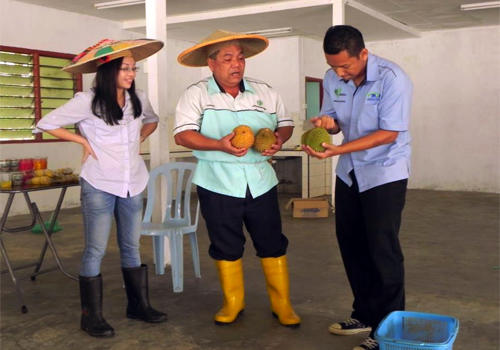Researchers take to the stage to explain value chains

Researchers use theatre as part of a participatory market chain approach to explain value chain concepts to tropical fruit tree farmers in India and Malaysia.
Working with partners in India and Malaysia, researchers from our Tropical Fruit Tree initiative are using a fun way to explain marketing to farmers and other actors along the value chain: theatre!
The Tropical Fruit Tree initiative works to improve livelihoods and food security through the conservation of tropical fruit tree diversity. We interviewed Bioversity International scientist Hugo Lamers, who leads the value chain and marketing research component, and introduced the tool as part of our Gender Research Fellowship Programme on participatory gender-responsive research.
Why use theatre as a way to communicate about the project to communities?
Theatre helps facilitate learning processes and explain difficult concepts. Concepts such as ‘marketing’ and ‘value chains’ are difficult for many smallholder farmers, who often have little experience or knowledge about markets. Many do not know what happens after selling their harvest to a trader, and many, especially women, often lack formal education. Visualizing market situations that they can recognize from their daily lives helps to explain key concepts related to marketing.
How did you find out about this approach?
The Participatory Market Chain Approach is a powerful method developed by the International Potato Center (CIP) to guide market innovation. One of its tools is to perform a 'market chain sketch' where facilitators play the roles of different value chain actors. We adapted this slightly to make it fit for our initiative which strives to enable farming communities to manage and create income from their native fruit tree diversity.
What were the key messages you were trying to get across with the play?
First, to explain the concept of a value chain – how their crops travel from farm to fork through many hands and that the value of the product increases along the value chain. Without knowing how your crops travel from farm to fork, you can’t make improvements in your market situation. Second, to make improvements in the value chain you have to listen to the demands and preferences of the final consumer, however unusual they sometimes are. Third, improvements in the value chain are best achieved through collaboration, among farmers, but especially by working together with traders and retailers.
What did the audience get out of the play? What did they learn?
The most important part is the discussion afterwards, by asking the audience what they learned from the play: “What situations did you recognize from your daily lives? What do you think are the key messages?”. Many times they picked up on all three key messages and came up with many more, resulting in interesting discussions.
Would you use theatre for other initiatives? In what context does it work well or not?
Yes, definitely. The results are quiet powerful. For example, the women’s group in Salkani village, India could still remember and easily explain the key lessons three months later. As researchers and project facilitators are also actors in the play, you start a working relationship with the community on a positive note. It gives something to the village and helps create a level playing field and conducive atmosphere for future activities and discussions. Above all, it’s great fun. However, it does not always work well. You need 4-5 facilitators who are willing and have time to spend at least one day before the meeting to discuss and preferably practice the script. Also, even though using theatre helps build trust between traders and farmers, sometimes the situation is too tense or sensitive to bring the groups together.
- View one of the plays ‘The Spineless Durian’ in this PowerPoint slideshow
- Read more about theatre and other activities to market native fruit diversity
This work is part of the UNEP-GEF funded initiative led by Bioversity International ‘Conservation and Sustainable Use of Cultivated and Wild Tropical Fruit Diversity: Promoting Sustainable Livelihoods, Food Security and Ecosystem Services’.Visit the website.
